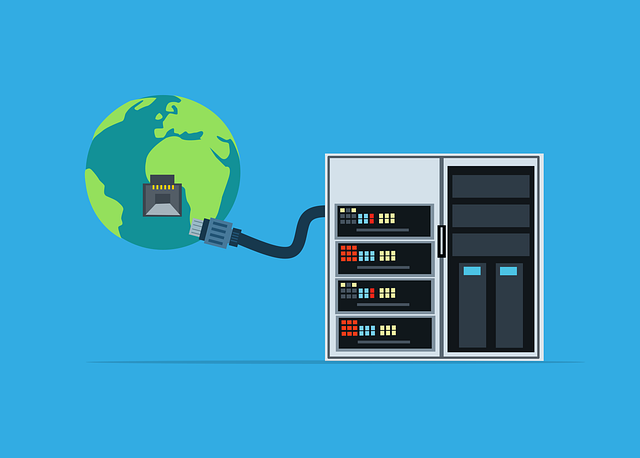Ethernet cabling is essential for modern networks, facilitating both voice and data connectivity via copper wires, fiber optics, and coaxial cables. Types like Cat5e and Cat6a cater to diverse network needs, with twisted-pair offering cost-effectiveness but limited speed, while fiber optic enables high-speed transmission over long distances. Secure Ethernet installation requires strategic planning, including layout design, high-quality cabling, careful routing, shielding, grounding, and regular testing to mitigate electromagnetic interference (EMI). Regular maintenance, proper labeling, and adherence to industry standards help prevent issues like physical damage, loose connections, and incorrect pin assignments. Keeping network infrastructure up-to-date ensures alignment with evolving technologies in voice and data cabling.
Ethernet cabling is a cornerstone of secure and stable internet connections, serving as the vital backbone for modern networks. This article delves into the essentials of Ethernet cabling basics, exploring types and standards. We examine the critical role of voice and data cabling in enhancing network security, providing best practices for installing secure connections, and offering troubleshooting tips for common issues. By understanding these aspects, IT professionals can ensure robust and safe data transmission across their networks.
Understanding Ethernet Cabling Basics: Types and Standards
Ethernet cabling forms the backbone of many modern networks, providing both voice and data connectivity. Understanding its basics is crucial for ensuring secure and stable internet connections. At its core, Ethernet cabling consists of twisted-pair copper wires, fiber optics, or coaxial cables that transmit data as electrical signals or light pulses.
The types and standards of Ethernet cabling vary widely, catering to different network requirements. Twisted-pair cabling, common in residential settings, supports slower speeds but is cost-effective. Fiber optic cabling, on the other hand, offers high-speed transmission over long distances, making it ideal for enterprise networks and data centers. Each type adheres to specific standards, such as Cat5e, Cat6a, or fiber modes like Single-Mode and Multimode, ensuring compatibility and performance.
The Role of Voice and Data Cabling in Network Security
Voice and data cabling plays a critical role in ensuring network security by providing a robust foundation for communication within an organization’s infrastructure. These cables facilitate the seamless transmission of both voice and data signals, serving as the backbone of any reliable networking system. By integrating advanced cabling solutions, businesses can significantly enhance their cybersecurity posture.
Secure Ethernet connections rely on well-designed voice and data cabling architectures that safeguard against potential threats. These include physical security measures to prevent unauthorized access and tampering with cables, as well as data encryption protocols to protect information during transit. Such comprehensive approaches not only maintain the integrity of network communications but also deter malicious activities aimed at disrupting or intercepting sensitive data.
Best Practices for Installing Secure Ethernet Connections
When installing secure Ethernet connections, adhering to best practices ensures optimal performance and data integrity. Begin by planning the layout meticulously, considering factors like distance, obstructions, and network density. High-quality materials, including reliable cables like Cat6a or higher for both voice and data cabling, are essential. Route cables carefully, minimizing bends and ensuring they’re secure from physical damage.
Terminations should be neat and correct, using compatible connectors and tools to prevent signal degradation. Shielding and grounding techniques play a vital role in mitigating electromagnetic interference (EMI). Regular testing and maintenance, such as checking for loose connections and verifying bandwidth capacity, help maintain the stability of your network infrastructure.
Troubleshooting Common Issues in Ethernet Cabling Systems
Ethernet cabling systems, while robust, can encounter issues that disrupt both voice and data communications. Troubleshooting begins with a visual inspection to identify any physical damage or loose connections. Even minor kinks or bends in the cable can cause intermittent signal loss. Regular maintenance involves checking connectors for dust or debris accumulation, which can impede transmission quality.
Beyond physical inspection, tools like cable testers can verify signal strength and data integrity. Common problems include crossover cables mispaired, incorrect pin assignments, or faulty connectors. Proper labeling of cable ends and adherence to industry standards (like TIA/EIA) for routing and termination significantly reduce such issues. Regular updates to network infrastructure, including cabling, are essential to keep pace with evolving technologies and maintain secure internet connections.
Ethernet cabling is a cornerstone of secure and reliable internet connectivity, facilitating both data transfer and voice communication. By understanding the various types and standards, implementing best practices for installation, and effectively troubleshooting common issues in voice and data cabling systems, individuals can ensure robust network security and optimal performance. These strategies are essential for creating a stable, safe, and efficient digital infrastructure.
